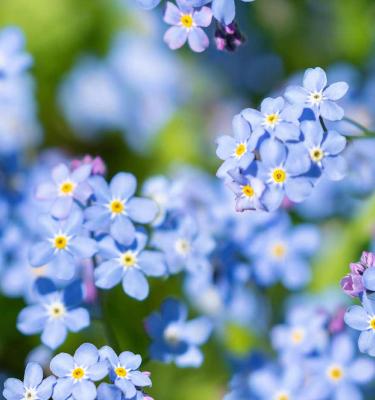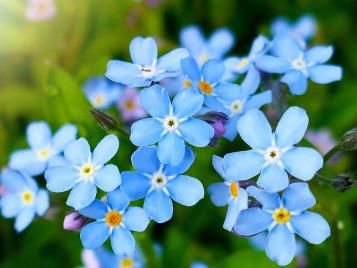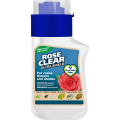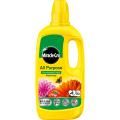

How To Grow and Look After Forget-Me-Nots In 5 Easy Steps
The vibrant blue flowers of Forget-Me-Nots make them a pretty choice for brightening a spring garden. They are super easy to grow, and can be grown in the ground or a container. Myosotis are loved by bees and butterflies, and the petals are edible too - the delicate flowers are perfect for sprinkling on top of a cake or a summer drink.
Types of Forget-Me-Nots to grow
Most types of Forget-Me-Not flowers are short-lived perennials, grown as biennials. This means that they begin to grow in the first year, and flower and die in their second year. They are sometimes thought of as perennials because they seed themselves freely, reappearing year after year.
Myosotis flowers are usually no more than 1cm across and consist of 5 flattish sky blue petals, and a yellow centre. They usually show off clusters of flowers from early spring until early summer. The leaves of many varieties of Forget-Me-Not are soft and hairy, and are said to resemble the ears of a mouse!
There are many Forget-Me-Not varieties to choose from. The most commonly grown varieties in the UK are:
- Myosotis alpestris (Alpine Forget-Me-Not). As well as the usual blue flowers, white and pink varieties are available too. It will grow especially well in an environment which replicates an alpine environment, so a rockery, gravel garden or difficult sloping area.
- Myosotis arvensis (Field Forget-Me-Not). Predominantly blue flowers, with the occasional pink flower coming through. Looks good in a naturalistic environment, such as a wildlife garden or wildflower area.
- Myosotis scorpioides (Water Forget-Me-Not). Perfect for near a pond where it can provide shelter for beneficial wildlife, such as newts and tadpoles. The Water Forget-Me-Not thrives in boggy conditions, and is a good plant to include as part of an aquatic garden.
- Myosotis sylvatica (Woodland Forget-Me-Not). A widely available type of Forget-Me-Not, it’s worth exploring some of the more unusual cultivars. Try ‘Blue Basket’ for darker blue flowers, ‘Victoria Rose’ for vivid pink flowers, and ‘Snowball’ for flowers which are pure white.

Where to sow your Forget-Me-Not flower seeds
Forget-Me-Nots are low growers so are really useful to fill space under taller plants and to provide ground cover in a border. They self-seed prolifically, so will quickly spread around the base of other plants, crowding out weeds and providing soil cover.
Myosotis are also a good plant to place along a path. Allow them to spread their loose and informal growth to soften a sharp path edge. Try planting them with Astrantia behind and foxgloves towards the back.
The attractive modest clumps of Forget-Me-Nots are useful as a backdrop for highlighting spring flowering bulbs, such as tulips and dog’s tooth violets. This can be in the wider garden, or as a display in pots and window boxes closer to home.
Most varieties of Myosotis need moisture retentive but well drained soil, although the water Forget-Me-Not needs constant moisture, and so is perfect for a pond. Myosotis prefer partial shade, but most can tolerate plentiful sun exposure and heavy shade too.
What you’ll need to grow Forget-Me-Nots
Forget-Me-Nots should be sown from March to June, or in September. They will flower the year after they have been sown.
When growing Forget-Me-Not flowers from seed, you will need:
- Gloves.
- Seed tray.
- Levington® Peat Free Seed & Cutting Compost.
- Forget-Me-Not seeds.
- Watering can.
Always wear gloves when handling compost and plants.
- Fill the seed tray with compost. Water it well.
- Sprinkle seed across the surface of the soil.
- Cover seeds with 0.5cm (1/4”) of compost.
- Place seed tray in a warm place, and keep well watered until the seeds have germinated.
- Once seedlings are large enough to handle, move to their final destination and water until established.
Alternatively, for an informal planting, Forget-Me-Not seeds can be sown directly in the ground from late April. Clear the area of weeds and stones, and then wet the surface of the soil. Sprinkle seeds across the soil, and then lightly rake it over.
How to look after Forget-Me-Nots
Forget-Me-Nots will usually grow well without much aftercare. They do not need to be fed, although a springtime application of mulch to a border is helpful for all plants. Forget-Me-Nots grown in containers should be watered frequently in warm weather to ensure they do not dry out.
To stop Forget-Me-Nots from spreading, pull them up as soon as they have finished flowering. Collect seeds for re-sowing by gently pulling up a dying plant and shaking the head of flowers into an envelope. Another option is to let them spread naturally, just removing any plants which pop up where they aren’t wanted.
Common pests and diseases with Forget-Me-Nots
Forget-Me-Nots are largely unaffected by pests. The only disease which may affect them is the fungal powdery mildew. Leaves will start to show a powdery white coating, and can eventually die.
You can prevent powdery mildew by keeping the soil around plants well watered, mulching in the spring, and avoiding splashing water onto leaves. Remove infected Forget-Me-Nots to the compost heap.
Frequently asked questions about Forget-Me-Nots
Are Forget-Me-Nots poisonous to dogs and cats?
No, the varieties of Forget-Me-Nots we have mentioned in this article are safe for dogs and cats.
Do Forget-Me-Nots come back every year?
Forget-Me-Nots usually grow and die within a 2 year lifecycle. However, they seed themselves freely, so they have a perpetual presence in the garden.
Are Forget-Me-Nots weeds?
‘Weed’ is a word which refers to any plant that grows where it is not wanted. Forget-Me-Nots are generally not seen as a weed. But if they are unwelcome, they are easy to remove by simply pulling them up.
Are Forget-Me-Nots edible?
Yes, the petals have lots of decorative uses in the kitchen. Try freezing them in ice cubes, sprinkling them into a salad, or decorating a white-icing covered cake with them.
Key features of Forget-Me-Nots
| Botanical Name | Myosotis |
|---|---|
| Plant Type | Biennial/short-lived perennial |
| Family | Boraginaceae |
| Light Exposure | Partial shade, but will tolerate full sun and shade |
| Soil pH | Neutral to slightly acidic |
| Flowering Time | April to June |
| Flower Colour | Blue, occasionally pink or white |




